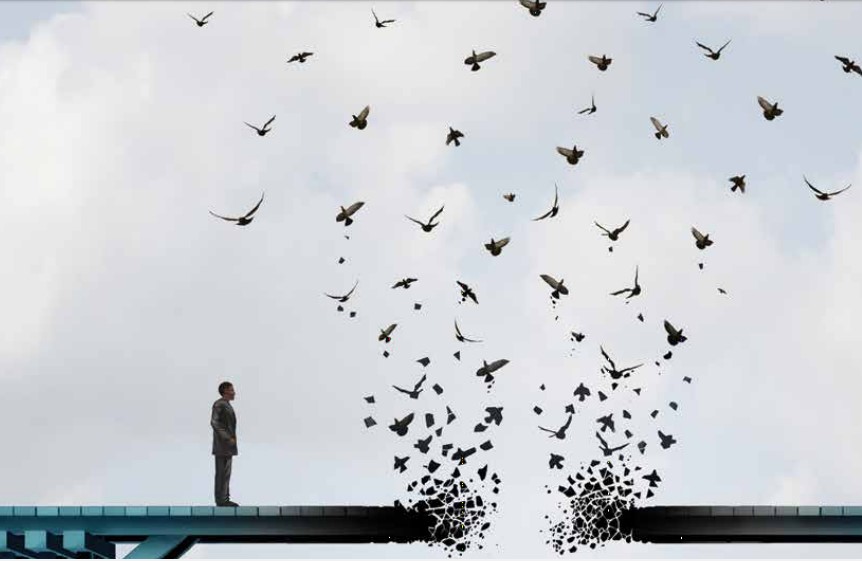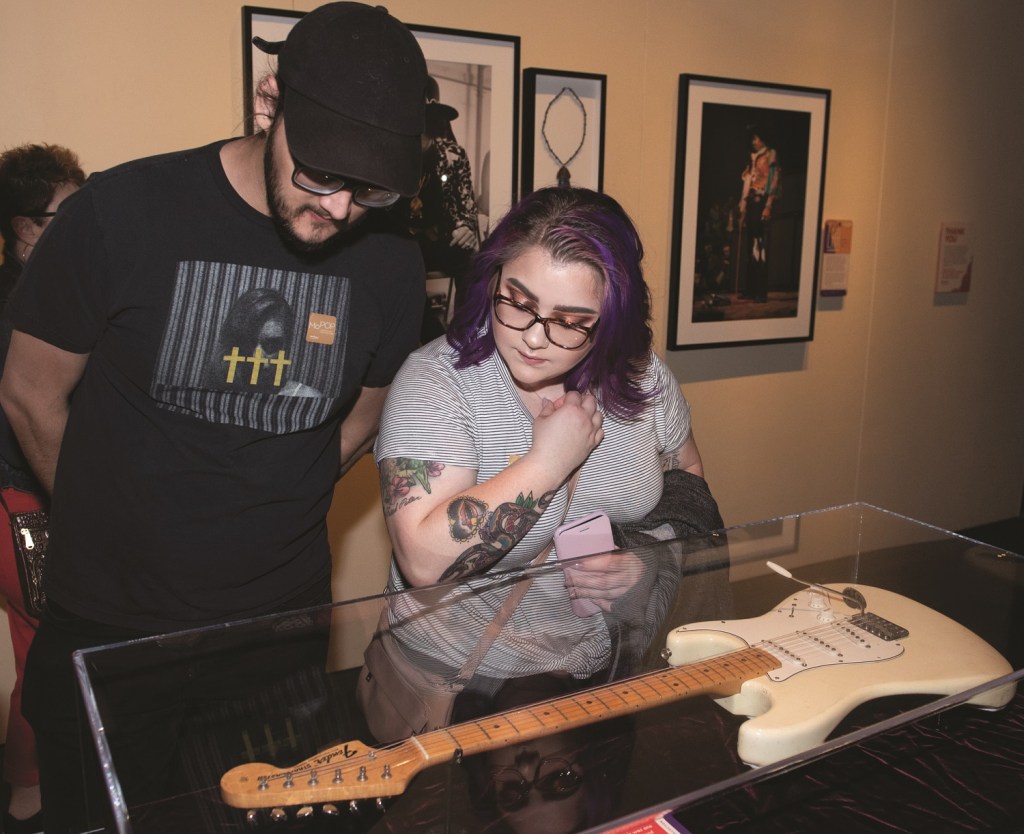
This article originally appeared in the Summer 2020 issue of Museum magazine, a benefit of AAM membership.
A little over a year ago, the Museum of Pop Culture began planning some in-gallery presentations for the museum’s celebration of the 75th birthday of Jimi Hendrix, the subject of one of the museum’s core galleries and one of Seattle’s favorite sons.
I began with research, diving deep into the content of the exhibition, looking through as much material as our curatorial staff could share with me, and reading a recent and well-regarded biography of the rock icon. The exhibition tells the story of the four most active years of Hendrix’s career and his relentless travel around the world in the late 1960s as the most popular and well-paid musician at the time.
One of the resources I encountered examined Hendrix’s life and career from a black perspective, a point of view that, in all honesty, I hadn’t previously thought much about. Throughout his career, Jimi Hendrix faced a fair amount of discrimination, especially in the late 1950s and early 1960s. At that time, as he played backup for other performers and in his own early bands, he was required to enter night clubs in the Jim Crow South through a back door. Later, when he had established his own innovative rock and blues musical style, he encountered white “gatekeepers” in the music business who tried to box him into musical styles they felt would sell more records.
These examples of Hendrix’s experience with race are not overtly addressed in our exhibition, which focuses on Hendrix’s travel and creative process on the road, though the first-person accounts in journals and song lyrics nod to his lived experience. But his life as a black man is part of the story that today’s visitors—especially younger ones—are interested in. We often bring students and young artists into this gallery and their questions about Hendrix’s identity have inspired us to bring his blackness into the conversation via additional photographs and materials, discussion questions, and closely looking at objects such as Hendrix’s personal journal, drawings, and draft song lyrics.
Museums of all types the world over are responding to the changing needs of their audiences, a paradigm shift in visitor demographics, and conversations about the purpose and definition of museums. As a result, educators, programmers, and interpreters are thinking differently about museum experiences, upending long-held norms with new practices in dialogue, community engagement, and other informal learning strategies. These new approaches often require educators to go “off-script,” pivoting away from the stories addressed in exhibitions and broadening the history, points of view, and interactions to respond to and engage with visitors.
Following are two example strategies—one working with museum staff and with physicians to address bias and the other working with teens to foster civic engagement. — Jason Porter

Museum Teaching to Mitigate Bias
By Theresa Sotto
Museum educators are experts in facilitating conversations about art that are grounded in visitors’ interpretations. While sharing multiple perspectives is usually a positive experience, conversations can become uncomfortable if a visitor makes a biased or offensive statement. Luckily, many educators are experienced in steering such conversations into productive terrain.
This is a skill set that museum educators can use to help others in our sector and those outside it to mitigate bias. The need is clearly there. A 2019 Glassdoor survey found that jobs related to diversity and inclusion initiatives have increased by 30 percent year over year in the US workforce, revealing a growing desire among companies across a range of sectors to proactively address discrimination and bias in workplace culture.
At the Hammer Museum at UCLA, I have been leading trainings to mitigate bias for staff and students and for external groups. Trainings take place in the galleries, where I use works of art to facilitate conversations about an individual’s subjective response to that art.
The purpose of this training is not to gain a deeper understanding about art, but to learn more about ourselves and our biases. Although some biases are helpful—such as a preference for healthy food—many biases are rooted in stereotypes that skew perspectives, cause microaggressions, and foster discriminatory behavior. Studies reveal that the first step in mitigating our biases is to become aware of them. Participants in this training, which have included UCLA medical students as well as museum staff, walk away with new insights into how aspects of their identities and lived experiences influence their decisions and give rise to biases.
One activity that I lead helps participants uncover their unconscious biases through associations. I invite participants to match a descriptive word to a work of art, and then we compare and contrast our choices and the reasons behind those choices. If someone is given the word “powerful,” for example, and selects a towering sculpture over a painting that depicts an act of protest, the individual may unconsciously associate height or physical dominance with power, even if, intellectually, they believe that using one’s voice is more powerful.
Museum educators have been using some variation of word association activities with school groups for years; however, going deeper into why we associate certain words with artworks can foster a new level of engagement—one that encourages deep self-reflection and, ultimately, responds to an urgent societal need.
For museum staff, this training can help employees double-check their impulses: Do I think this visitor might touch the art because I witnessed a specific behavior or because I have a bias that clouds my judgement?
In the medical field, my hope is that doctors will become more self-reflective about their diagnoses. A multitude of studies over the years have shown that non-white patients get less optimal care. If doctors better understood their biases, obviously it wouldn’t undo systemic racism, but it would be a start.
Civics-Inspired Approaches to Working with Teens
By Kayleigh Bryant-Greenwell
When we experiment with unconventional approaches in museum programming, such as methods inspired by civic engagement and social justice, we can share authority with our communities. When I came to the Smithsonian American Art Museum (SAAM) from the Smithsonian’s National Museum of African American History and Culture, I began to ask questions about both the inclusion of communities in program development and how the format of these programs could incorporate social justice.
Were we providing programming opportunities for communities to take the lead? Were our offerings considering a spectrum of engagement strategies? As museums adapt to new expectations of 21st century visitors, we must consider the ways in which we permit or barricade visitor experiences.
In the fall of 2019, SAAM developed its first-ever, free Teen Arts Workshop series. The goal was to create a more audience-centered program to encourage more “in the moment” discovery and informal interaction with civically engaged ideas and concerns.
In conjunction with our “American Myth & Memory: David Levinthal Photographs” exhibition, which featured enlarged Polaroids of staged miniature dioramas depicting the American West, Barbies, and sports figures, we created a program in which youth explored the idea of “being American.”
The program brought 10 teen participants from different backgrounds and schools into dialogue about the exhibition, their experiences of the media, and their own backgrounds. The group led their own discussion about American beauty standards and the idolization of sports figures with limited guidance from our educators.
Building on that success, we planned a second workshop with our “Chiura Obata: American Modern” exhibition that featured works the artist completed while imprisoned in a Japanese incarceration camp during World War II. We partnered with Andrea Kim Neighbors, a colleague at Smithsonian Asian Pacific American Center, to co-create a civics-inspired space where meaning-making could take root.

Photo by Wei Wei Chen for SAAM
Instead of guiding teens through the exhibition with called-out works and accompanying questions as we did with the Levinthal exhibition, we encouraged them to explore the artwork on their own, using the “see, think, wonder” model. We also developed a hands-on art-making activity related to the experience of Japanese incarceration in America. Shizu Salamando, teaching artist and descendant of incarceration survivors, found through researching her family heritage and Japanese-American history, archival footage, and artifacts that incarcerated Japanese-Americans crafted paper flower wreaths to use in celebrations and funerals at the camps.
After visiting the gallery, the teens created their own flowers, and upon completion, put their creations together into their own unique depiction of a community wreath. Salamando made the experience even more relevant when she discussed with the participants the act of wreath-laying that happens today along the Mexican border.
As we developed a self-driven space for teens in SAAM’s public programming, we intentionally employed civics-inspired strategies. As our public programming priorities are increasingly driven by outreach and audience cultivation, I am particularly curious if civics-inspired programming can be used to shift our internal museum cultures toward less authoritative and more inclusive practice—as well as shift public perception of what a museum experience can be.
The purpose of this training is not to gain a deeper understanding about art, but to learn more about ourselves and our biases.
Jason Porter is the director of education and programs at the Museum of Pop Culture in Seattle, Washington. Theresa Sotto is associate director of academic programs at the Hammer Museum in Los Angeles, California. Kayleigh Bryant-Greenwell is the head of public programs at the Smithsonian American Art Museum in Washington, DC.







